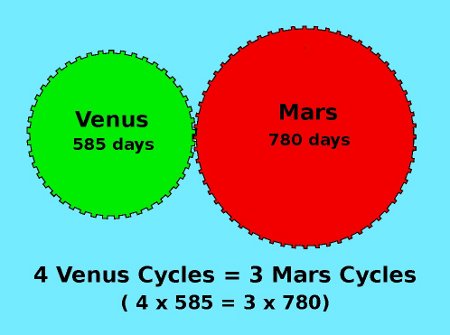
29 Sep 2014, 1 Deer (SR), 1 Resurrection (UMa)
©2014 by John P. Pratt. All rights Reserved.
| 1. Uniform Mars Calendar |
| 1.1 Correlation to Gregorian |
| 1.2 Sacred Round |
| 2. Witness of Events |
| 2.1 Mortality & Resurrection |
| 2.2 Patriarchs |
| 2.3 Patriarchs' Wives |
| 2.4 Old Testament Dates |
| 2.5 Latter-day Events |
| 2.6 AD 70 Fall of Jerusalem |
| 3. Conclusion |
| Notes |
Note: Minor corrections have been made to the Mars Calendar phase lengths which changed some of these results as discussed in "Updated Mars Calendars Testify of Sacred Dates" (7 Jul 2018). This article remains as originally published. Any dates of sacred events on the Mars Calendar presented in this article which changed have been updated in the Religious Chronology on my website.
This article introduces the Uniform Mars Calendar. Another article published earlier today introduced its counterpart, the Mars Calendar.[1] This new calendar brings the total to thirteen sacred calendars which testify of the dates of key religious events throughout history. Along with the others, the Uniform Mars Calendar (UMa) witnesses many dates in the lives of ancient patriarchs from the Biblical Book of Genesis, dates in the life of Jesus Christ including the date of the Resurrection, and some modern-day dates. The new UMa dates have been entered into the Religious Chronology page.
There are two types of sacred calendars. One type actually tracks the location of a planet (or other celestial body) in the heavens. Each has a distinct pattern, based usually on key orbital points. Each also needs to occasionally insert or skip "leap days" to accurately follow it, because the true cycle length never is an exact number of days. The Mars Calendar is this type of calendar.
 |
The Uniform Mars Calendar tracks 780-day cycles. The Uniform Venus Calendar always has 585 days per cycle. That means that 3 Uniform Mars cycles exactly equals four Uniform Venus cycles because 3 x 780 = 4 x 585. They are like two gears of those ratios synchronized together for all of history, as shown in Figure 1.
 |
The days of each phase are simply numbered sequentially, such as 1 Birth, 2 Birth, etc. The first and the last day of each phase are holy days. The last day of the last phase uses the notation of being day 0 of the next phase, so that the last is first and the first is last. In other words, the day 0 Translation can for some purposes be thought of as the first of Translation (even though 1 Translation is technically the first) and yet it is also the last day of Prime. All of the "0" days are transition days.
Because all uniform calendars never insert any "leap days", all that is needed to use them is to find one day in history known on our usual (Gregorian) calendar and match them up. Once that is done, every other day in history automatically is determined. That is, one can then say what any date in history is on the Uniform Mars Calendar by simply counting days around the known pattern in Table 1.
The decision of what day to line up is called the "correlation" of the calendar. For the Uniform Mars Calendar (UMa), after sufficient research, it has been determined to align the day 1 Adult (UMa) with the day of the Beginning of Mortality on Sun 9 Apr 4001 BC, beginning at noon, when the UMa day begins.
The reason for that choice will be apparent when it is seen how many sacred events line up on meaningful (rather than just any) holy UMa days. There is a possibility that it is not the correct correlation, especially if a better one can be found. That happened with the Uniform Venus Calendar, but every effort has been made to insure that this correlation is correct.
An example of a meaningful date is that the day that was proposed in 2003[2] for the translation of the prophet Enoch falls on the day 0 Translation (UMa). That is a bull's-eye, rather than just any holy day that has no special meaning. That is also a witness to the correctness of the calendar phase length pattern. Another witness is that in the Mars article it was shown that Moses was translated on the day 1 Translation on the Mars (Ma) Calendar.
All of the planetary sacred calendars are tied to the 13-day trecena of the Sacred Round. The trecena is a continuously repeating series of thirteen days, numbered from 1 to 13. Just as the week is a repeating series of 7 days, with no extra day ever inserted, so is the trecena with 13 days.
Each of the nine phases begins on a day "1" of a trecena. That is true of all of the planetary calendars and their uniform counterparts. But in the case of the Uniform Mars Calendar, the tie to the Sacred Round is much stronger, so let's take a closer look at it.
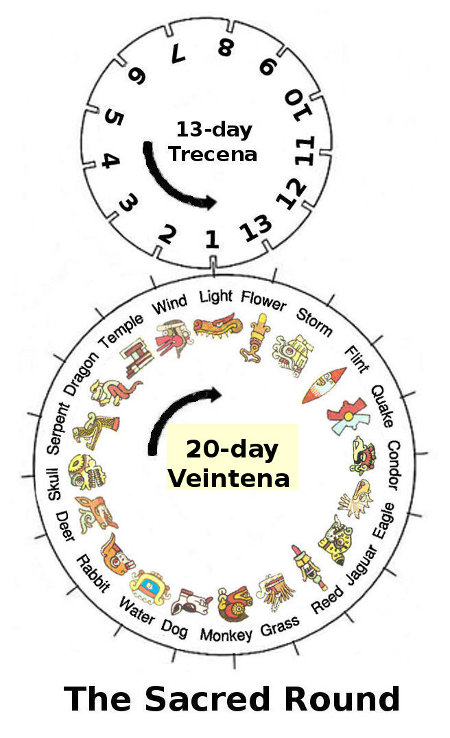 |
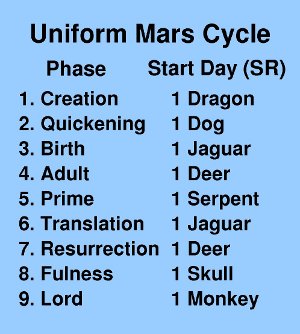 |
Note that both birth and translation (which replaces death) occur on 1 Jaguar. That interval spans exactly two Sacred Rounds. On the Venus Calendar, the interval from birth to death was exactly one Sacred Round, so there is order and design in these calendars. Similarly, on this calendar, the interval from Adult, when evil enters a person's life to Resurrection when it can be overcome, spans exactly one Sacred Round. This is such an important symbolism that it is built right into the calendar.
Consider an example of the alignment with the Sacred Round. In the correlation section above, it was said that the correlation is such that the Beginning of Mortality falls on 1 Adult. Because that day was 1 Deer, that means that 1 Adult (UMa) will always throughout history fall on 1 Deer (SR) Because there are two Sacred Rounds between 1 Adult and 1 Resurrection, it also means that the day 1 Resurrection also always falls on the day 1 Deer. Today, the day this article is being published is 1 Deer (until 6 am), which is also 1 Resurrection (UMa) until noon. This publication date was chosen to represent the Uniform Mars Calendar being resurrected on the proper day.
Another feature of this calendar is that the days on the Uniform Mars Calendar never coincide with the same day on the Mars Calendar. With both the Mercury and Venus calendars, there were periods in which the two calendars would coincide for a few years when the positions of the actual planets happened to match the uniform version of the calendars. But in the case of the Mars and Uniform Mars Calendars, the adjustments to the Mars Calendar are only made about every 440 years on the average. That would take about 20 x 440 = 8,800 year for the two calendars to cycle all the way around and repeat. So in 7,000 years, it does not make it all the way around. It turns out that the proposed correlation of the Uniform Mars Calendar is one that would be outside of the 7,000 years of possibilities, and hence that calendar never coincides with the Mars Calendar.
Consider the example of the Prophet Enoch's translation on Wed 12 Oct 2948 BC (all dates are on our Gregorian Calendar), on 13 Reed (SR). There is no day in history when 0 Translation (Ma) falls on 13 Reed (SR). Note that 13 Reed is the day preceding 1 Jaguar (1 follows 13 and Jaguar follows Reed). Looking at Table 2, sure enough, 1 Translation (the day after 0 Translation) always falls on 1 Jaguar. So the Uniform Mars Calendar worked perfectly for his translation date. In this sense it appears that the Mars Calendar and Uniform Mars Calendar can work together as a team of witnesses. That is, when one cannot be used, the other might be available.
Now that the details of the Uniform Mars Calendar are understood, let's turn to looking at what sacred events occurred on what holy days.
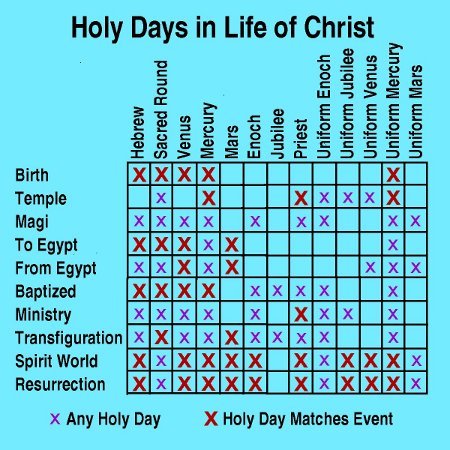 |
Now in this calendar we find the counterpart in the large scale of this miniature symbolism. The day of the Beginning of Mortality was 1 Adult (UMa). That is a perfect day for leaving the Garden of Eden and beginning the journey of a fallen couple. The counterpart date on the large scale was apparently the date of the Resurrection of Christ, which was 0 Resurrection (Ma). In this pair, the uniform version of the Mars Calendar supplies the beginning date and the usual Mars Calendar the end date. The two seem to be working as a team to testify.
Other dates in the life of Christ were on holy days on the Uniform Mars Calendar. The proposed date of the Magi occurred on 1 Prime (UMa), the return from Egypt on 1 Creation (UMa) and the trip to the Spirit World and the Resurrection both occurred on the day 0 Creation (UMa). That means a total of four of the ten key events in the life of Christ which have been studied in these articles occurred on holy days.
What is especially amazing is that the days of the Spirit World and the Resurrection were holy on both the Mars and the Uniform Mars Calendars. That is way beyond chance, but it wasn't all chance. The choice of the correlation of this calendar was partly made by the fact that when the calendar was aligned on a holy day at the Beginning of Mortality the Resurrection fell on a holy day. But then the choice was verified by so many other dates falling into line. In any case, the score is now that the Spirit World and Resurrection both fell on holy days on twelve of the thirteen known sacred calendars, as shown in Table 3!
Many dates of key events in the lives of the ancient patriarchs fell on holy days on the Uniform Mars Calendar. They are shown in Table 4.
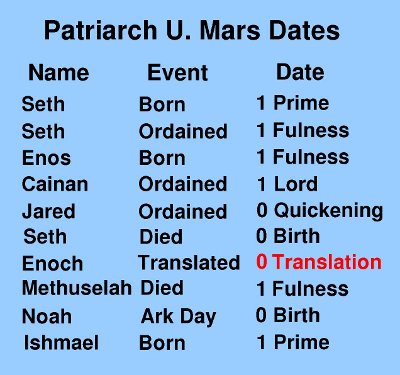 |
Look at the three dates in the table for Seth, the son of Adam. All three of the dates known for his life are holy days on the Uniform Mars Calendar: his birth, his ordination, and his death. Those are three witnesses. They fall on three different holy days, so the intervals between the dates need to be perfect. Usually just having two dates in one life being holy are a sufficient witness that it is not a random hit, but meaningful. But three make it even more clear.
Of course, the other sign that it is correct is the number of "bull's-eyes" where the event date is not just any holy day, but the one matching the event. Those perfect hits are shown in red in the Table 4. In the case of these patriarchs none of them are born on the day 1 Birth, but that is partly because so many were born on 1 Birth on the Mars Calendar. Remember, it is impossible to be born on 1 Birth on both calendars because they never coincide.
The one date in red in that table is, however, indeed impressive. The day of Enoch's translation, a rare event indeed, fell exactly on 0 Translation (UMa). That is a strong vote for the correctness of this correlation. And in the Mars Calendar paper it was noted that the translation of Moses occurred on the day 1 Translation on that calendar. Those two are also compelling support for the whole notion that "Translation" should replace "Death" on the Mars Calendars.
In the Mars Calendar article, the wives of the Patriarchs were only mentioned in passing. That was because so many of their vital dates occurred on holy days on both the Mars and the Uniform Mars Calendar, and the latter had not yet been introduced. Those are important witnesses because the two calendars never align on the same holy days on the same dates.
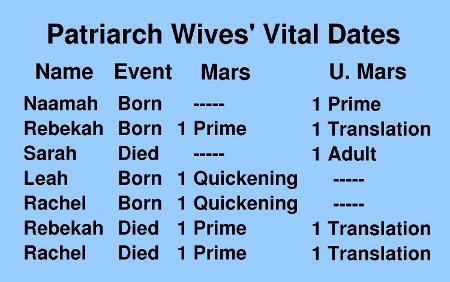 |
Naamah was the wife of Noah. In an earlier paper she was thought to have been born on a holy day on the Uniform Venus Calendar. Then an error in the correlation was discovered, and her birth date was no longer holy on that calendar. But now it is seen that it turns out to be holy on the Uniform Mars Calendar instead.
Note also that Rebekah's life spanned an exact number (62) of Uniform Mars Cycles. Moreover, both her birth and death dates were holy days on both the Mars and Uniform Mars Calendars. That is really impressive.
Notice also that only one of the holy days in the tables for both the patriarchs and their wives falls on the day 1 Adult. That is the day when evil enters into a life, which would not be appropriate for most of their holy days. In the case of Sarah, her death was associated with the sacrifice of Isaac. That sacrifice was symbolic of the atonement of Christ for the Fall of Adam, and so it was totally appropriate for it to fall on the same day as the Beginning of Mortality. If these alignments on holy days were random, then many would fall on 1 Adult just by chance, but they don't.
There are several miscellaneous dates from Old Testament history that are worth mentioning as being holy days on the Uniform Mars Calendar.
The first is the date on which Joseph of Egypt appeared before Pharaoh. That proposed date was published long ago in my articles, and it has always been surprising how important that date was, being holy on multiple sacred calendars. Now it turns out to have been both 1 Prime (Ma) and also 1 Translation (UMa). That means it was a holy day on seven different sacred calendars. The meanings of these multiple alignments is not always immediately obvious, but they do indeed seem to testify of the importance of certain events.
Another is the date of the Brazen Serpent during the time of Moses. Besides being a holy day on seven other sacred calendars, now it turns out it was 1 Fulness (UMa). It was a holy day indeed.
Similarly, the date of the giving of the Book of Deuteronomy is one date where the exact day is given at the beginning of that very book (Deut. 1:3). The proposed date on our calendar was published in 2003, but there was always something puzzling about it. That day was 1 Dog (SR), the day of greatest suffering, which did not seem appropriate. None of the prophets in my Chronology were born on that day. In fact, even now, it is the only event occurring on that day in that list.
Now a reason for that emerges. The day was 1 Quickening on both the Mercury and Uniform Mercury Calendars. That day is so common on those short term calendars, it is not obvious that those alignments were meant to be meaningful. But now it turns out that the day was also 1 Quickening (UMa) which only occurs once every 780 days. That means it is like the second hand and minute hand both pointing to 12 o'clock, but now it is discovered that the hour hand points there too. Now it seems significant, and with three witnesses that the day was a classic 1 Quickening day. That is the day when the spirit comes, a perfect day for a sacred book to be revealed.
 |
Another date is the day that the manna stopped appearing on the ground to provide food for the Israelites for forty years. That day symbolized the death of Jesus Christ, when the "Bread of Life" was taken away. That day was already known to be holy on seven sacred calendars, but now it shows up as 0 Birth (UMa). That is a great day to represent the beginning of a new era.
Another similar day occurred shortly thereafter during the time of Joshua, when he uttered the famous "Choose ye this day whom ye will serve" challenge. That day was also holy on seven sacred calendars, but now an eighth one is added because it was also 1 Creation (UMa). Again, that is a great day to start a new era because it is the first day of the cycle.
There are only a few miscellaneous events during the latter-day restoration which fall on holy days (UMa). There is a set of three in a row at the time of the coming forth of the book of Mormon. Any one by itself would seem like a random coincidence, but when there are three then it seems worth mentioning in case future discoveries make it more obvious why these events fell on holy days.
 |
The day 26 Mar 1829 has been proposed in my articles as the day it was announced that there would be three witnesses to the Book of Mormon. It has been noted that it was holy on four sacred calendars, including the Venus Calendar where it formed part of a set of three dates forming what was called the "Creation Pattern."[4] Now another sacred calendar declares that to have been a holy day: it was 1 Lord (UMa).
The final date in this set ties into this very story. Martin Harris was replaced as the scribe because of losing the first 116 pages, which were never recovered. On Tue 7 Apr 1829 a new scribe named Oliver Cowdery began work. In 2002, that day was noted in my articles as having been an important day on the Enoch Calendar.[5] It was also holy on three other sacred calendars. Now it is found also to be the day 0 Creation (UMa), which again has the symbolism of starting a new time period. And indeed it did, it was the beginning of Oliver Cowdery's work, who completed the task successfully. He went on to become a second witness with Joseph Smith of many events and the Second Elder of the Church of Jesus Christ of Latter-day Saints when it was founded.
Taking these three dates together, and the coherence of their meanings, these three holy day alignments do not appear to be chance coincidences. They testify to the importance not only of the Book of Mormon, but to the contribution of Oliver Cowdery as being the principal scribe of that sacred book.
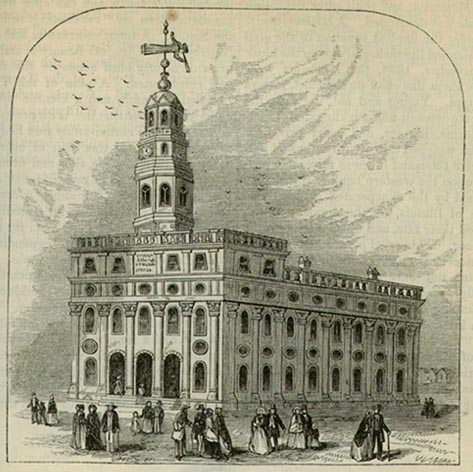 |
These dates do not seem to be the most important of the restoration, which tended to fall on holy days on the Venus and other sacred calendars. But the fact that these calendars testify of them, shows that they may not have been fully appreciated in the past.
One of the dates that has never been mentioned in my articles is the date of the Fall of Jerusalem in AD 70. There were two major Fall of Jerusalem dates, and two Burning of the Temple dates. Both events occurred first in the summer of 587 BC, and then again in the summer of AD 70.
Three of the four dates have been discussed in my work, and they tend to occur on anniversaries of the Fall of Adam. For example it was pointed out that the AD 70 Burning of the Temple occurred on the same day as the Fall of Adam on the Priest and Mercury Calendars, and on the day of Burning on the Jubilee Calendar. This was not a date determined by the Sacred Calendars, but the exact date recorded by Josephus.[6]
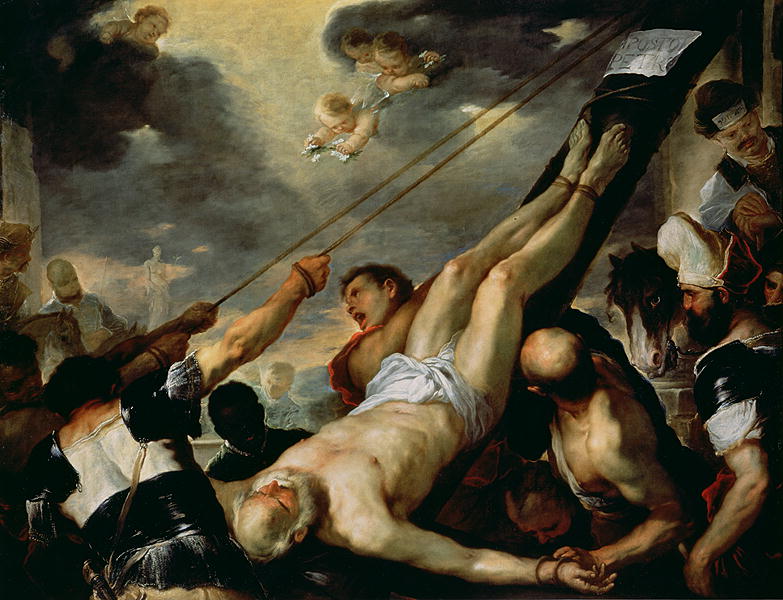 |
A closely related date also shows up here, which has not been mentioned in my articles. It is the date three and a half years before the Fall of Jerusalem on which the siege began. That day, Mon 7 Apr AD 67 fell on the day 1 Resurrection (UMa). Resurrection might not sound like a match, but the date of the siege of the temple in the time of Nebuchadnezzar, given to the very day in two books of the Bible, fell on 1 Resurrection on both the Venus and Mercury Calendars. So it is consistent with precedent, if not of obvious interpretation. On other sacred calendars that day was 1 Death on both the Mercury and Uniform Mercury calendars. That ominous alignment is easier to find symbolism in.
There is another date which occurred during this same time period which needs to be included. The martyrdom of the apostle Peter, when he was crucified upside down, has been discussed in detail in a previous article.[7] His death fell on one of the holiest dates in history: Sat 4 Jun 67 after 6 pm was Firstfruits (PHC, J, P), 1 Dragon (SR), 1 Creation (V), 1 Adult (UV), 1 Death (M, UM), and Oil (UJ). That means it was known to be holy on 9 out of 11 Sacred calendars before the two Mars Calendars were discovered. Now it turns out that the day was also 1 Resurrection (Ma) and 1 Creation (UMa). That means it was holy on 11 of the known 13 sacred calendars. The only other date known to me that was holy on 11 of 13 was the Beginning of Mortality. The only more holy dates, holy on 12 of the 13, were the date of the redemption of the Spirit World, and the resurrection of Jesus Christ.
The Uniform Mars Calendar has been introduced, explained, and correlated to our Gregorian Calendar. Its pattern is identical to the Mars Calendar, but, as with all uniform calendars, it is never adjusted with leap days to track the actual planet.
Many dates of key religious events throughout history were shown to have fallen on its holy days. These included the pair of dates of the Beginning of Mortality and the Resurrection of Christ. Many key dates in the life of the patriarchs and their wives were noted as falling on its holy days. Other biblical events were discussed as occurring on holy days, as well as latter-day events. The siege and fall of Jerusalem in AD 67-70 were also shown to be similar to the pattern of the same event in the days of Nebuchadnezzar.
It is concluded that far too many religious events occurred on its holy days to have happened by chance. This calendar appears to be a bona fide sacred calendar used in the planning of key religious events throughout history, including being a testimony of events in the life of Jesus Christ.